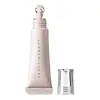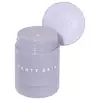What's inside
What's inside
 Key Ingredients
Key Ingredients

 Benefits
Benefits

 Concerns
Concerns

 Ingredients Side-by-side
Ingredients Side-by-side

Water
Skin ConditioningDimethicone
EmollientIsododecane
EmollientPEG-10 Dimethicone
Skin ConditioningGlycerin
HumectantDimethicone/Vinyl Dimethicone Crosspolymer
Skin ConditioningPolymethylsilsesquioxane
Trimethylsiloxysilicate
EmollientPEG/PPG-18/18 Dimethicone
EmulsifyingSodium Chloride
MaskingDisteardimonium Hectorite
StabilisingSodium Potassium Aluminum Silicate
Phenoxyethanol
PreservativePotassium Sorbate
PreservativeSodium Dehydroacetate
PreservativeAluminum Hydroxide
EmollientHydroxyethylcellulose
Emulsion StabilisingSilica
AbrasiveTriethoxycaprylylsilane
Pentylene Glycol
Skin ConditioningSimmondsia Chinensis Seed Oil
EmollientCitric Acid
BufferingFructose
HumectantSodium Hydroxide
BufferingUrea
BufferingSodium Hyaluronate
HumectantAllantoin
Skin ConditioningMaltose
MaskingSodium Lactate
BufferingSodium PCA
HumectantTrehalose
HumectantGlucose
HumectantDisodium Phosphate
BufferingPolysorbate 60
EmulsifyingSodium Phosphate
BufferingIron Oxides
CI 77891
Cosmetic ColorantCI 77163
Cosmetic ColorantWater, Dimethicone, Isododecane, PEG-10 Dimethicone, Glycerin, Dimethicone/Vinyl Dimethicone Crosspolymer, Polymethylsilsesquioxane, Trimethylsiloxysilicate, PEG/PPG-18/18 Dimethicone, Sodium Chloride, Disteardimonium Hectorite, Sodium Potassium Aluminum Silicate, Phenoxyethanol, Potassium Sorbate, Sodium Dehydroacetate, Aluminum Hydroxide, Hydroxyethylcellulose, Silica, Triethoxycaprylylsilane, Pentylene Glycol, Simmondsia Chinensis Seed Oil, Citric Acid, Fructose, Sodium Hydroxide, Urea, Sodium Hyaluronate, Allantoin, Maltose, Sodium Lactate, Sodium PCA, Trehalose, Glucose, Disodium Phosphate, Polysorbate 60, Sodium Phosphate, Iron Oxides, CI 77891, CI 77163
Water
Skin ConditioningGlycerin
HumectantCaprylic/Capric Triglyceride
MaskingStearic Acid
CleansingPropanediol
SolventTrioctyldodecyl Citrate
EmollientNiacinamide
SmoothingSqualane
EmollientArachidyl Alcohol
EmollientCarthamus Tinctorius Oleosomes
EmollientShorea Stenoptera Seed Butter
EmollientDicaprylyl Carbonate
EmollientAcetyl Hexapeptide-8
HumectantCaffeine
Skin ConditioningHyaluronic Acid
HumectantSodium Hyaluronate
HumectantPolyglutamic Acid
Skin ConditioningTamarindus Indica Seed Polysaccharide
Skin ConditioningSodium PCA
HumectantManganese PCA
HumectantMagnesium PCA
HumectantZinc PCA
HumectantAdansonia Digitata Seed Oil
EmollientCitrullus Lanatus Seed Oil
EmollientAlbizia Julibrissin Bark Extract
MaskingMalpighia Glabra Fruit Juice
Skin ConditioningEscin
TonicPanthenol
Skin ConditioningTocopherol
AntioxidantGluconolactone
Skin ConditioningSynthetic Beeswax
Emulsion StabilisingMaltodextrin
AbsorbentGlucose
HumectantArachidyl Glucoside
EmulsifyingBehenyl Alcohol
EmollientGlyceryl Caprylate
EmollientLauroyl Lysine
Skin ConditioningSodium Polyacrylate
AbsorbentXanthan Gum
EmulsifyingMica
Cosmetic ColorantCaprylhydroxamic Acid
Tetrasodium Glutamate Diacetate
Sorbitan Isostearate
EmulsifyingSodium Benzoate
MaskingCaprylyl Glycol
EmollientPotassium Sorbate
PreservativeHydroxyethyl Acrylate/Sodium Acryloyldimethyl Taurate Copolymer
Emulsion StabilisingBis-Diglyceryl Polyacyladipate-2
EmollientDimethicone
EmollientCitric Acid
BufferingPhenoxyethanol
PreservativeCI 77891
Cosmetic ColorantCI 77491
Cosmetic ColorantWater, Glycerin, Caprylic/Capric Triglyceride, Stearic Acid, Propanediol, Trioctyldodecyl Citrate, Niacinamide, Squalane, Arachidyl Alcohol, Carthamus Tinctorius Oleosomes, Shorea Stenoptera Seed Butter, Dicaprylyl Carbonate, Acetyl Hexapeptide-8, Caffeine, Hyaluronic Acid, Sodium Hyaluronate, Polyglutamic Acid, Tamarindus Indica Seed Polysaccharide, Sodium PCA, Manganese PCA, Magnesium PCA, Zinc PCA, Adansonia Digitata Seed Oil, Citrullus Lanatus Seed Oil, Albizia Julibrissin Bark Extract, Malpighia Glabra Fruit Juice, Escin, Panthenol, Tocopherol, Gluconolactone, Synthetic Beeswax, Maltodextrin, Glucose, Arachidyl Glucoside, Behenyl Alcohol, Glyceryl Caprylate, Lauroyl Lysine, Sodium Polyacrylate, Xanthan Gum, Mica, Caprylhydroxamic Acid, Tetrasodium Glutamate Diacetate, Sorbitan Isostearate, Sodium Benzoate, Caprylyl Glycol, Potassium Sorbate, Hydroxyethyl Acrylate/Sodium Acryloyldimethyl Taurate Copolymer, Bis-Diglyceryl Polyacyladipate-2, Dimethicone, Citric Acid, Phenoxyethanol, CI 77891, CI 77491
 Reviews
Reviews

Ingredients Explained
These ingredients are found in both products.
Ingredients higher up in an ingredient list are typically present in a larger amount.
Ci 77891 is a white pigment from Titanium dioxide. It is naturally found in minerals such as rutile and ilmenite.
It's main function is to add a white color to cosmetics. It can also be mixed with other colors to create different shades.
Ci 77891 is commonly found in sunscreens due to its ability to block UV rays.
Learn more about CI 77891Citric Acid is an alpha hydroxy acid (AHA) naturally found in citrus fruits like oranges, lemons, and limes.
Like other AHAs, citric acid can exfoliate skin by breaking down the bonds that hold dead skin cells together. This helps reveal smoother and brighter skin underneath.
However, this exfoliating effect only happens at high concentrations (20%) which can be hard to find in cosmetic products.
Due to this, citric acid is usually included in small amounts as a pH adjuster. This helps keep products slightly more acidic and compatible with skin's natural pH.
In skincare formulas, citric acid can:
While it can provide some skin benefits, research shows lactic acid and glycolic acid are generally more effective and less irritating exfoliants.
Most citric acid used in skincare today is made by fermenting sugars (usually from molasses). This synthetic version is identical to the natural citrus form but easier to stabilize and use in formulations.
Read more about some other popular AHA's here:
Learn more about Citric AcidDimethicone is a type of synthetic silicone created from natural materials such as quartz.
What it does:
Dimethicone comes in different viscosities:
Depending on the viscosity, dimethicone has different properties.
Ingredients lists don't always show which type is used, so we recommend reaching out to the brand if you have questions about the viscosity.
This ingredient is unlikely to cause irritation because it does not get absorbed into skin. However, people with silicone allergies should be careful about using this ingredient.
Note: Dimethicone may contribute to pilling. This is because it is not oil or water soluble, so pilling may occur when layered with products. When mixed with heavy oils in a formula, the outcome is also quite greasy.
Learn more about DimethiconeGlucose is a simple sugar and is the most important source of energy in all organisms.
In skincare, glucose is used to hydrate the skin. It also acts as a prebiotic for our natural biome.
Glucose is hydrating due to its humectant property. As a humectant, glucose draws moisture from the air and from deeper levels in the skin.
Our skin contains many sugars that act as prebiotics and help strengthen our natural microbiome. Having a healthy microbiome helps protect our skin from harmful bacteria and other contaminants.
Studies show glucose may help with fading discoloration and pigmentation. This is because our skin metabolizes glucose into lactic acid. Lactic acid is an AHA that helps exfoliate the top layer of skin.
Learn more about GlucoseGlycerin is already naturally found in your skin. It helps moisturize and protect your skin.
A study from 2016 found glycerin to be more effective as a humectant than AHAs and hyaluronic acid.
As a humectant, it helps the skin stay hydrated by pulling moisture to your skin. The low molecular weight of glycerin allows it to pull moisture into the deeper layers of your skin.
Hydrated skin improves your skin barrier; Your skin barrier helps protect against irritants and bacteria.
Glycerin has also been found to have antimicrobial and antiviral properties. Due to these properties, glycerin is often used in wound and burn treatments.
In cosmetics, glycerin is usually derived from plants such as soybean or palm. However, it can also be sourced from animals, such as tallow or animal fat.
This ingredient is organic, colorless, odorless, and non-toxic.
Glycerin is the name for this ingredient in American English. British English uses Glycerol/Glycerine.
Learn more about GlycerinPhenoxyethanol is a preservative that has germicide, antimicrobial, and aromatic properties. Studies show that phenoxyethanol can prevent microbial growth. By itself, it has a scent that is similar to that of a rose.
It's often used in formulations along with Caprylyl Glycol to preserve the shelf life of products.
Potassium Sorbate is a preservative used to prevent yeast and mold in products. It is commonly found in both cosmetic and food products.
This ingredient comes from potassium salt derived from sorbic acid. Sorbic acid is a natural antibiotic and effective against fungus.
Both potassium sorbate and sorbic acid can be found in baked goods, cheeses, dried meats, dried fruit, ice cream, pickles, wine, yogurt, and more.
You'll often find this ingredient used with other preservatives.
Learn more about Potassium SorbateSodium Hyaluronate is hyaluronic acid's salt form. It is commonly derived from the sodium salt of hyaluronic acid.
Like hyaluronic acid, it is great at holding water and acts as a humectant. This makes it a great skin hydrating ingredient.
Sodium Hyaluronate is naturally occurring in our bodies and is mostly found in eye fluid and joints.
These are some other common types of Hyaluronic Acid:
Learn more about Sodium HyaluronateSodium PCA is the sodium salt of pyroglutamic acid. It is naturally occurring in our skin's natural moisturizing factors where it works to maintain hydration.
The PCA stands for pyrrolidone carboxylic acid, a natural amino acid derivative.
This ingredient has skin conditioning, anti-inflammatory, and humectant properties. Humectants help hydrate your skin by drawing moisture from the air. This helps keep your skin moisturized.
Learn more about Sodium PCAWater. It's the most common cosmetic ingredient of all. You'll usually see it at the top of ingredient lists, meaning that it makes up the largest part of the product.
So why is it so popular? Water most often acts as a solvent - this means that it helps dissolve other ingredients into the formulation.
You'll also recognize water as that liquid we all need to stay alive. If you see this, drink a glass of water. Stay hydrated!
Learn more about Water